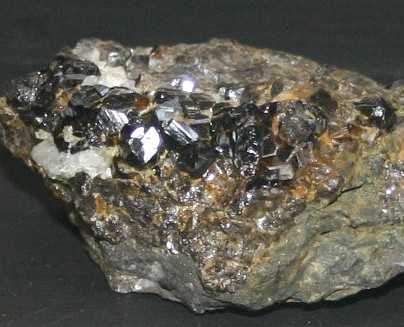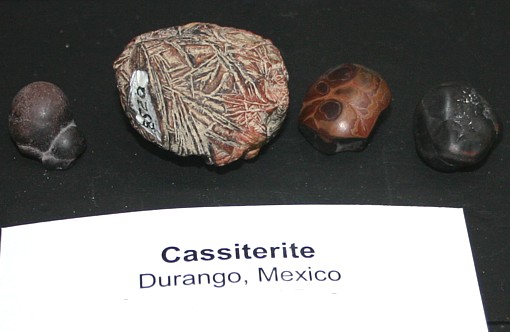Tin is said to have been found native, but, if so, is of very rare occurrence. It is chiefly found in the form of the oxide, cassiterite (tinstone), which may be regarded as the sole important source of the metal. The mineral stannite, a sulfide of copper, iron, and tin, is of little significance as an ore mineral. Tin is a bright, white metal, malleable and ductile. It has a specific gravity of 7-3, and melts at 232 C. A bar of the metal, when bent, emits a crackling sound. The chief use of tin is in the coating or manufacture of tin-plate (sheet-iron with a very thin coating of tin) and the tin plate thus formed is used in roofing. Tin is use din alloys such as pewter, tinfoil, solder, and antifriction metals, and bronze and bell metals, as a part of pewter in various utensils, etc. An amalgam of tin and mercury is used in "silvering" mirrors. The artificial oxide of tin is used as a polishing powder. Stannic chloride is employed as a mordant in dyeing.
Cassiterite is obtained from both lodes and alluvial (placer) deposits. In the former it may be associated with arsenic, copper ore and iron pyrite, wolframite, etc., and in alluvial deposits it is often associated with ilmenite or titaniferous iron, monazite, zircon, topaz, tourmaline, etc. Cassiterite is a mineral which, while occurring in small quantities in many localities, is found only in a comparatively few commercial deposits. The proportion of tin in ores is usually expressed in pounds of black tin (tinstone containing about 70 per cent, metal) per ton. In the case of alluvial deposits, less than 2 pounds per ton has been profitably worked. The alluvial or mine stuff is concentrated, up to as near 70 per cent, of metallic tin as is practicable, by means of shaking tables and other mechanical contrivances, and when associated with ilmenite, wolframite, or other magnetic minerals, by electro-magnetic separators. The dressed product or "concentrate" is smelted in reverberatory furnaces, and the metal further purified up from 99.2 to 99.9 per cent. Salts of tin have uses in the pottery and enameled iron industries and as a mordant in calico printing.
Cassiterite is found sparingly distributed in some igneous rocks and is a constituent of some pegmatites and of a few contact metamorphic deposits. Cassiterite occurs in pneumatolytic veins, associated with acid rocks, granites, as in Cornwall. It occurs also in many veins, nearly all of which are of deep-seated origin. The main occurrence of cassiterite is in quartz veins, associated with fluorite, topaz, tourmaline, axinite, and apatite, as in Cornwall, Saxony, and Bolivia. Stannite is found in many deposits in Bolivia, particularly at Potosi. Both stannite and cassiterite are almost insoluble in ground water; consequently tin deposits are enriched near the surface when other minerals are removed by solution.
Minor veins of cassiterite are sometimes found in rhyolite flows, in which they were evidently formed shortly after the consolidation of the rock. We have here then high temperature deposits originating near the surface. It may be recalled that topaz is sometimes found in lithophysse in rhyolite and these phenomena indicate a retention by the lavas of certain of their volatile constituents until consolidation of the rock. Such deposits contain concretionary cassiterite and "wood tin" associated with hematite, chalcedony, and opal, sometimes also with wolframite and bismuth minerals. Occurrences of this kind have been described from Mexico and from Nevada.
Cassiterite is extremely resistant to weathering, as shown, for example, by its occurrence in placers. It is held by some authors that the so-called fibrous tin ore or "wood tin" which is often found in placers is a product of alteration of cassiterite, but the question does not seem to be definitely settled. If secondary, it is probably derived from stannite. Much tin is obtained from placers, and fully one half of the world's supply of tin is obtained from placer deposits, resulting from the degradation of tin veins. Localities of alluvial tin deposits are Malay States; the islands of Banka and Billeton, in Indonesia; Cornwall; Mount Bischoff, in Tasmania, etc. Of the total world's production of tin ore, about 80 percent is contributed by the Malasia, Thailand, Bolivia, and Indonesia. The remainder is produced chiefly in England, Australia, Congo, Russia, and Somalia.
The chief primary vein sources of tin are and the lode deposits of Bolivia, Congo and Cornwall. The Malaysian ore is obtained chiefly from alluvial deposits that have been derived from the disintegration of the older rocks of the Peninsula. These rocks consist of slates, schists and crystalline limestones, into which granites are intrusive. The tin ores were introduced with the granite intrusion and were deposited for the most part in the surrounding sedimentary rocks. The region is notable as furnishing an example of the deposition of tin ore in crystalline limestone, this feature being well exemplified in the crystalline limestone of the Kinta district in Perak. The primary veins in the limestone have a matrix of calcite. The veins are in some places very rich in cassiterite, with little or no other associated minerals; but as a rule pyrite, chalcopyrite, arsenopyrite, and fluorite are found in the veins. An interesting feature is provided by the occurrence of primary pipes of tin ore in the limestone. The ore of these pipes, like that of the veins, consists of cassiterite and sulphides in a matrix of calcite. Another interesting feature of the limestone deposits is the occurrence of secondary pipes infilled by the weathering residues of the limestone. The presence of cassiterite makes these pipe infillings valuable as tin ore. Tin ore also occurs in the form of disseminations, veins, and pockets in the granite, associated with quartz, tourmaline, and topaz. At one locality a pipe of tin ore in granite has been worked. This pipe resembles those occurring in the Waterberg tinfield of the Transvaal.
Most of the Malaysian tin-ore has, however, been obtained from the alluvial or detrital deposits that have been derived from the disintegration of the vein formations by weathering and denudation. These deposits occur superficially for the most part and are easily worked. The minerals commonly found associated with cassiterite in the alluvial deposits include ilmenite, arsenopyrite, wolframite, monazite, topaz, and tourmaline. Placer tin deposits of Asia: The granitic ridge which forms the backbone of the Malasian Mountains stretches southwards into the islands of Banka and Billiton in Indonesia, and northward into Myanmar (Burma), Thailand and the province of Yunnan in China; and in all these areas the granitic intrusions are associated with deposits of tin ore. Indonesia has contributed large supplies of tin ore. Here the origin and mode of occurrence of the alluvial deposits are much the same as in the Malasia. The tins bearing alluvium forms a bed about 3 feet thick lying on the granites and slates, and is covered by a layer of clayey and sandy overburden, the thickness of which averages about 30 feet.
In Myanmar and Thailand also the mining has been largely alluvial. In Myanmar, the chief districts are those of Mergui and Tavoy, where granites are intrusive in slates and quartzite. The tin ore (cassiterite) is found as a constituent of stringers, veins, and pegmatites, associated with granitic intrusions; but it occurs also in the surface alluvium derived from these. The cassiterite is associated with wolframite. In China, tin ore is found abundantly in the province of Yunnan, notably in the Mengtze district, where cassiterite is associated with pyrite and chalcopyrite in limestones that are supposed to be of Permian to Triassic age. Granite intrusions have penetrated these limestones, which contain veins and pipes of tin ore. In the weathering zone the limestone is traversed by fissures, and the red clay filling these fissures and other cavities contains cassiterite. The conditions of occurrence in Yunnan thus recall those met with in various parts of the Kinta limestone deposits of Perak. Tests: Heated on charcoal with sodium carbonate and charcoal, tin compounds are reduced to the metal, which is soft and malleable. The encrustation given by heating tin compounds alone on charcoal, when moistened with cobalt nitrate and strongly reheated, is a blue-green color.
The United States at present produces only a small amount of tin ore as the tin deposits of the United States are consistently small. In the Carolina tin belt, that extends from Gaffney, S. C., nearly to Lincolntown, N. C., cassiterite occurs in pegmatite, which is characterized by abundant muscovite, quartz, and a little plagioclase feldspar. At Silver Hill, about 8 miles southeast of Spokane, Wash., and at the Etta mine, South Dakota, cassiterite is found in pegmatite dikes. Tin veins are also found in the Franklin Mountains, Texas, about 12 miles north of El Paso. In the Temescal tin district, in western Riverside County, California, the tin deposits are veins in granite. The district has produced some tin, but the mine is now closed. The vein matter is dark tourmaline, high in iron and quartz, with which cassiterite is associated. Arsenopyrite and copper minerals are reported. The tin oxide is distributed either through the vein matter or in stringers and bunches. The average of the ore milled contained about 5 per cent of the oxide. On Lost River, Seward Peninsula, Alaska, where granite intrudes limestone, a contact metamorphic zone is developed, in which some cassiterite is found. Cassiterite is also found in this region in granite and in quartz veins. Historically, most of the production of US domestic tin ores in the United States comes mainly from Alaska.
Return
to Metal Ores Page:
Precious and Base Metal Ores

Crystaline Cassiterite, tin oxide. Tin ores are concentrated in relatively few locations around the world. Nice crystal specimens like this are rare.

Most of the world's tin ores are found in alluvial pieces like these, known as wood tin because the similarity of the grains to those of the grain in wood. Cassiterite is heavy and resistant to chemical weathering, so it collects in alluvial placer deposits with other heavy minerals.
